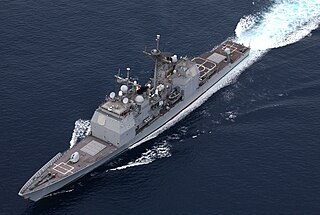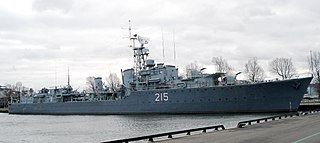Related Research Articles

In naval terminology, a destroyer is a fast, maneuverable, long-endurance warship intended to escort larger vessels in a fleet, convoy or battle group and defend them against powerful short range attackers. They were originally developed in 1885 by Fernando Villaamil for the Spanish Navy as a defense against torpedo boats, and by the time of the Russo-Japanese War in 1904, these "torpedo boat destroyers" (TBDs) were "large, swift, and powerfully armed torpedo boats designed to destroy other torpedo boats". Although the term "destroyer" had been used interchangeably with "TBD" and "torpedo boat destroyer" by navies since 1892, the term "torpedo boat destroyer" had been generally shortened to simply "destroyer" by nearly all navies by the First World War.

The Aegis Combat System is an American integrated naval weapons system developed by the Missile and Surface Radar Division of RCA, and now produced by Lockheed Martin. It uses powerful computer and radar technology to track and guide weapons to destroy enemy targets.

HMCS Athabaskan was a Tribal-class destroyer that served with the Royal Canadian Navy in the immediate post-Second World War era. She was the second destroyer to bear the name "Athabaskan", after the many tribes throughout western Canada that speak Athabaskan family languages. Both this ship and the original HMCS Athabaskan were destroyers and thus this one became known as Athabaskan II.

Destroyer escort (DE) was the United States Navy mid-20th-century classification for a 20-knot warship designed with the endurance necessary to escort mid-ocean convoys of merchant marine ships.

The C and D class was a group of 14 destroyers built for the Royal Navy in the early 1930s. As in previous years, it was originally intended to order a complete flotilla comprising eight destroyers—plus a flotilla leader as the ninth unit—in each year. However, only four ships—plus a leader—were ordered under the 1929–1930 Programme as the C class. The other four ships planned for the C class were never ordered as an economy measure and disarmament gesture by the Labour government of Ramsay MacDonald. A complete flotilla—the 'D' class—was ordered under the 1930–1931 Programme.

The Tribal class, or Afridi class, were a class of destroyers built for the Royal Navy, Royal Canadian Navy and Royal Australian Navy that saw service in World War II. Originally conceived during design studies for a light fleet cruiser, the Tribals evolved into fast, powerful destroyers, with greater emphasis on guns over torpedoes than previous destroyers, in response to new designs by Japan, Italy, and Germany. The Tribals were well admired by their crews and the public when they were in service due to their power, often becoming symbols of prestige while in service.

The Town-class destroyers were a group of 50 destroyers of the Royal Navy and the Royal Canadian Navy that were in service during the Second World War. They were transferred from the United States Navy in exchange for military bases in the British West Indies and Newfoundland, as outlined in the Destroyers for Bases Agreement between Britain and United States, signed on 2 September 1940. They were known as "four-pipers" or "four-stackers" because they had four smokestacks (funnels). Later classes of destroyers typically had one or two.

The Buckley-class destroyer escorts were 102 destroyer escorts launched in the United States in 1943–44. They served in World War II as convoy escorts and anti-submarine warfare ships. The lead ship was USS Buckley which was launched on 9 January 1943. The ships had General Electric steam turbo-electric transmission. The ships were prefabricated at various factories in the United States, and the units brought together in the shipyards, where they were welded together on the slipways.

The Captain class was the designation given to 78 frigates of the Royal Navy, constructed in the United States, launched in 1942–1943 and delivered to the United Kingdom under the provisions of the Lend-Lease agreement. They were drawn from two classes of the American destroyer escort classification: 32 of the GMT (Evarts) Type and 46 of the TE (Buckley) Type. Upon reaching the UK the ships were substantially modified by the Royal Navy, making them distinct from the US Navy destroyer escort ships.

HMCS Crescent was a C-class destroyer that was built for the Royal Navy but was transferred before completion and saw active service with the Royal Canadian Navy. She was one of 32 destroyers of that class built between 1943 and 1945 as part of the War Emergency Programme.

Captain (Capt) is a senior officer rank of the Royal Navy. It ranks above commander and below commodore and has a NATO ranking code of OF-5. The rank is equivalent to a colonel in the British Army and Royal Marines, and to a group captain in the Royal Air Force. There are similarly named equivalent ranks in the navies of many other countries.

The Battle of Ushant, also known as the Battle of Brittany, occurred on the early morning of 9 June 1944 and was an engagement between German and Allied destroyer flotillas off the coast of Brittany. The action came shortly after the initial Allied landings in Normandy. After a confused engagement during the night the Allies sank one of the German destroyers and forced another ashore, where she was wrecked.
HMS Kingsmill (K484) was a British Captain-class frigate of the Royal Navy in commission during World War II. Originally constructed as the United States Navy Evarts-class destroyer escort DE-280, she served in the Royal Navy from 1943 to 1945 and then in the U.S. Navy as USS Kingsmill (DE-280) from August to October 1945.
The British 5th Destroyer Flotilla, or Fifth Destroyer Flotilla, was a naval formation of the Royal Navy from 1910 to 1942 and again from 1947 to 1951.
The British 6th Destroyer Flotilla, or Sixth Destroyer Flotilla, was a military formation of the Royal Navy from 1911 to 1939 and again from 1947 to 1951
The 7th Destroyer Flotilla, also styled as the Seventh Destroyer Flotilla, was a military formation of the Royal Navy from 1911 to 1939.
The 8th Destroyer Flotilla, also styled as the Eighth Destroyer Flotilla, was a military formation of the British Royal Navy from 1911 to 1939.
The 9th Destroyer Flotilla, or Ninth Destroyer Flotilla, was a military formation of the British Royal Navy from January 1913 to December 1925 and again in January to July 1940.
The British 10th Destroyer Flotilla, or Tenth Destroyer Flotilla, was a military formation of the Royal Navy from March from 1914 to 1919. It was reformed on an ad hoc basis from 1940 to 1941 and finally from 1944 to 1945.
References
- ↑ Whitby, Michael (2011). Commanding Canadians: The Second World War Diaries of A.F.C. Layard. Vancouver, Canada: UBC Press. p. Abbrev: XV. ISBN 978-0-7748-4037-8.